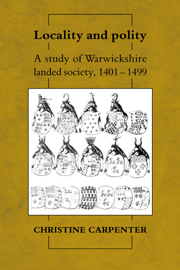Book contents
- Frontmatter
- Contents
- List of figures and tables
- Preface
- List of abbreviations
- Note on text
- 1 Introduction
- PART I STRUCTURAL
- 2 Geography, economy and regional identity
- 3 Who were the gentry?
- 4 Social mobility and the creation of estates
- 5 The exploitation of estates
- 6 Expenditure and dispersal
- 7 Conclusions: land, family and lineage
- 8 The local officers
- PART II CHRONOLOGICAL
- Appendices
- Bibliography
- Index
2 - Geography, economy and regional identity
Published online by Cambridge University Press: 27 October 2009
- Frontmatter
- Contents
- List of figures and tables
- Preface
- List of abbreviations
- Note on text
- 1 Introduction
- PART I STRUCTURAL
- 2 Geography, economy and regional identity
- 3 Who were the gentry?
- 4 Social mobility and the creation of estates
- 5 The exploitation of estates
- 6 Expenditure and dispersal
- 7 Conclusions: land, family and lineage
- 8 The local officers
- PART II CHRONOLOGICAL
- Appendices
- Bibliography
- Index
Summary
Warwickshire lies in a region that has been called ‘the centre of England’, and the centre of England does indeed lie in this county, at Meriden just south of Coventry. As befits its position, the county is one of the principal crossroads of England, where two great Roman roads, Watling Street and the Fosse Way, and one minor one, Ryknield Street, converge, along with a later road from Worcester to Birmingham that Higden, not quite accurately, also called Ryknield Street and described as one of the ‘Four great Royal Roads of England’. Coventry itself lay at a nodal point of the medieval road network. The county accordingly possessed enormous strategic importance, not only because of its command of central communications but also because it links north midlands to south, and east midlands to the Welsh borderland. That the midlands should become a major battleground four times during ‘The Wars of the Roses’, at Blore Heath, Northampton, Edgcote and Bosworth (five times if we include Tewkesbury, just over the south-west Warwickshire border), was perhaps inevitable. But, as Goodman has shown, it was also vital to control the area because of its importance as a recruiting ground; in practice whoever got there first tended to win not only the recruiting contest but the battle that followed.
Goodman's work also reveals the indispensability of the towns in raising forces and as providers of war loans.
- Type
- Chapter
- Information
- Locality and PolityA Study of Warwickshire Landed Society, 1401–1499, pp. 17 - 34Publisher: Cambridge University PressPrint publication year: 1992



